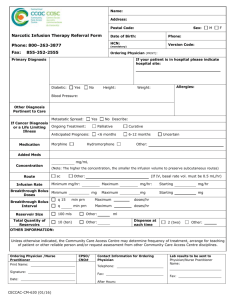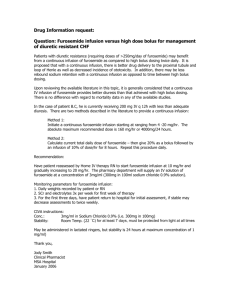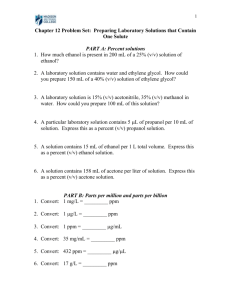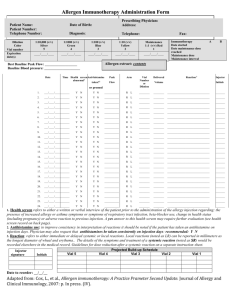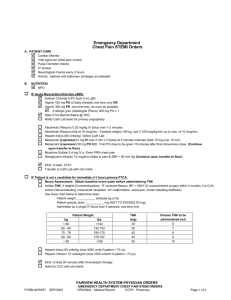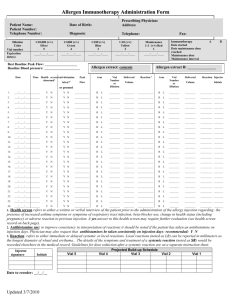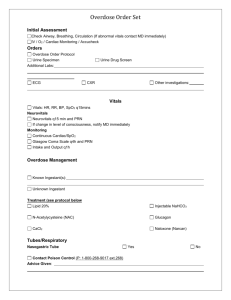Administration of intravenous drugs
advertisement
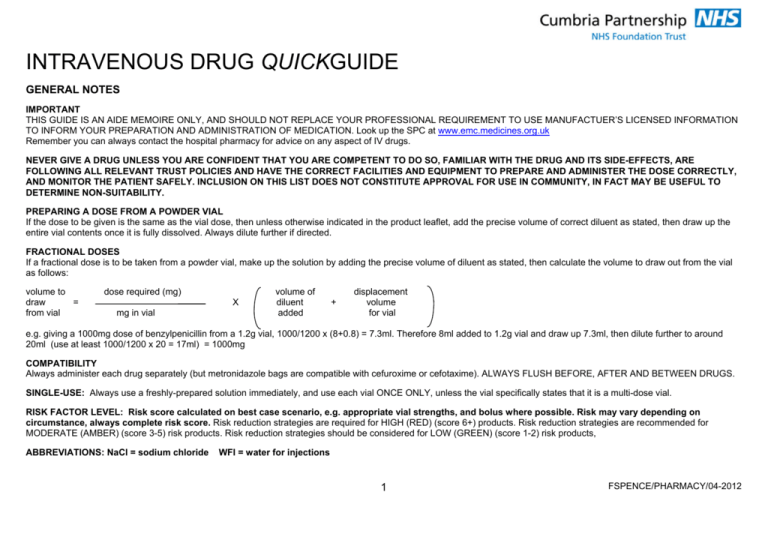
INTRAVENOUS DRUG QUICKGUIDE GENERAL NOTES IMPORTANT THIS GUIDE IS AN AIDE MEMOIRE ONLY, AND SHOULD NOT REPLACE YOUR PROFESSIONAL REQUIREMENT TO USE MANUFACTUER’S LICENSED INFORMATION TO INFORM YOUR PREPARATION AND ADMINISTRATION OF MEDICATION. Look up the SPC at www.emc.medicines.org.uk Remember you can always contact the hospital pharmacy for advice on any aspect of IV drugs. NEVER GIVE A DRUG UNLESS YOU ARE CONFIDENT THAT YOU ARE COMPETENT TO DO SO, FAMILIAR WITH THE DRUG AND ITS SIDE-EFFECTS, ARE FOLLOWING ALL RELEVANT TRUST POLICIES AND HAVE THE CORRECT FACILITIES AND EQUIPMENT TO PREPARE AND ADMINISTER THE DOSE CORRECTLY, AND MONITOR THE PATIENT SAFELY. INCLUSION ON THIS LIST DOES NOT CONSTITUTE APPROVAL FOR USE IN COMMUNITY, IN FACT MAY BE USEFUL TO DETERMINE NON-SUITABILITY. PREPARING A DOSE FROM A POWDER VIAL If the dose to be given is the same as the vial dose, then unless otherwise indicated in the product leaflet, add the precise volume of correct diluent as stated, then draw up the entire vial contents once it is fully dissolved. Always dilute further if directed. FRACTIONAL DOSES If a fractional dose is to be taken from a powder vial, make up the solution by adding the precise volume of diluent as stated, then calculate the volume to draw out from the vial as follows: volume to draw = from vial dose required (mg) X mg in vial volume of diluent added + displacement volume for vial e.g. giving a 1000mg dose of benzylpenicillin from a 1.2g vial, 1000/1200 x (8+0.8) = 7.3ml. Therefore 8ml added to 1.2g vial and draw up 7.3ml, then dilute further to around 20ml (use at least 1000/1200 x 20 = 17ml) = 1000mg COMPATIBILITY Always administer each drug separately (but metronidazole bags are compatible with cefuroxime or cefotaxime). ALWAYS FLUSH BEFORE, AFTER AND BETWEEN DRUGS. SINGLE-USE: Always use a freshly-prepared solution immediately, and use each vial ONCE ONLY, unless the vial specifically states that it is a multi-dose vial. RISK FACTOR LEVEL: Risk score calculated on best case scenario, e.g. appropriate vial strengths, and bolus where possible. Risk may vary depending on circumstance, always complete risk score. Risk reduction strategies are required for HIGH (RED) (score 6+) products. Risk reduction strategies are recommended for MODERATE (AMBER) (score 3-5) risk products. Risk reduction strategies should be considered for LOW (GREEN) (score 1-2) risk products, ABBREVIATIONS: NaCl = sodium chloride WFI = water for injections 1 FSPENCE/PHARMACY/04-2012 TABLE FOR PREPARATION AND ADMINISTRATION OF IV MEDICATION Typical Adult Medication generic name dose and dose interval (assumes no renal/hepatic impairment) aciclovir 5-10mg/kg EVERY 8 HOURS amoxicillin 500mg-1g EVERY 6-8 HOURS aztreonam 1-2g EVERY 6, 8 OR 12 HOURS Displacement volume (to be taken into account for fractional doses) Suitable diluent for initial reconstitution of powder Negligible, also comes readymixed NaCl 0.9% Suitable volume for diluting powder/final volume for bolus administration 10ml per 250mg then must dilute to at least 5mg/ml Speed of bolus injection (bolus often preferred if possible) Suitable fluid and volume for infusion Speed of infusion Risk Factor Score (NPSA) NOT FOR BOLUS ADMININSTRATION 500mg/100ml NaCl 0.9% 60 minutes 5 0.2ml/250mg benzylpenicillin 600mg-3g (or can be higher) EVERY 4-6 HOURS cefotaxime 1g EVERY 12 HOURS (though can be up to 12g daily in 3-4 doses) Draw up entire vial contents for full dose Draw up entire vial contents for full dose WFI 5ml per 250mg e.g. 20ml for 1g 3-4 minutes NaCl 0.9% 50-100ml 30-60 minutes 2 WFI 10ml 3-5 minutes NaCl 0.9% 50-100ml per 1g 20-60 minutes 1 WFI or NaCl 0.9% 4ml per 600mg DOSES >1.2g MUST BE GIVEN BY INFUSION At least 2 minutes per 600mg. Preferred 10ml per 600mg given over 5-10 minutes Doses over 1.2g must be infused NaCl 0.9% 50-100ml 30-60 minutes 3 WFI solution is straw-coloured (okay to reconstitute with Minibag Plus) 1g vial– 4ml 2g vial– 10ml 3-5 minutes Acceptable, but bolus preferred See SPC 1 0.4ml/600mg Draw up entire vial contents for full dose 0.5ml/1g vial Draw up entire vial contents for full dose 2 FSPENCE/PHARMACY/04-2012 TABLE FOR PREPARATION AND ADMINISTRATION OF IV MEDICATION Typical Adult dose and dose interval (assumes no renal/hepatic impairment) Displacement volume (to be taken into account for fractional doses) Suitable diluent for initial reconstitution of powder Suitable volume for diluting powder/final volume for bolus administration Speed of bolus injection (bolus often preferred if possible) Suitable fluid and volume for infusion Speed of infusion Risk Factor Score (NPSA) ceftazidime (see leaflet for specific reconstitution guidance) 1g EVERY 8 HOURS or 2g EVERY 12 HOURS but can be 0.55ml/500mg WFI or NaCl 0.9% 5ml/500mg 10ml/1-2g 15ml/3g 3-5 minutes NaCl 0.9% 50-100ml 20-60 minutes 2 ceftriaxone (1g bolus ONLY) 1g EVERY 24 HOURS 0.5ml/1g WFI 10ml 2-4 minutes n/a n/a 1 NOT FOR BOLUS ADMINISTRATION 40ml NaCl 0.9% added to vial and administer from vial via giving set 2g to be given over 30 minutes 2 Medication generic name up to 6g/day ceftriaxone (2g infusion ONLY) 2g EVERY 24 HOURS 1.03ml/2g NaCl 0.9% 40ml ALWAYS READ LEAFLET AS MAY VARY BY BRAND cefuroxime 750mg-1.5g EVERY 8 HOURS (or can be inc to 6-hourly) 0.54ml/750mg WFI 6ml/750mg 15ml/1.5g 3-5 minutes NaCl 0.9% 50-100ml 30 minutes 2 clarithromycin 500mg EVERY 12 HOURS reconstituted solution = 50mg/ml WFI 10ml/500mg then must dilute NOT FOR BOLUS ADMINISTRATION NaCl 0.9% 250ml 60 minutes 3 clindamycin Can be up to 3g divided into 2-4 doses daily NOT FOR BOLUS ADMINISTRATION NaCl 0.9% Must not be more than 18mg/ml, e.g. 600mg in 50ml Minimum 10 minutes for every 300mg 2 Ready-mixed Ready-mixed n/a 3 FSPENCE/PHARMACY/04-2012 TABLE FOR PREPARATION AND ADMINISTRATION OF IV MEDICATION Medication generic name co-amoxiclav (contains a penicillin) daptomycin (Black triangle drug) Typical Adult dose and dose interval (assumes no renal/hepatic impairment) 1.2g EVERY EIGHT HOURS (can be increased to every 6 hours) 4 - 6mg/kg EVERY 24 HOURS ertapenem 1g every 24 hours flucloxacillin 250mg-1g EVERY 6 HOURS (can be up to 2g every 6 hours) furosemide gentamicin Displacement volume (to be taken into account for fractional doses) Suitable diluent for initial reconstitution of powder Suitable volume for diluting powder/final volume for bolus administration Speed of bolus injection (bolus often preferred if possible) Suitable fluid and volume for infusion Speed of infusion Risk Factor Score (NPSA) 0.5ml/600mg WFI 10ml per 600mg 3-4 minutes NaCl 0.9% 50ml per 600mg 30-40 minutes 2 negligible NaCl 0.9% 1ml per 50mg 2 minutes (but infusion preferred as clinically proven) NaCl 0.9% 50ml 30 minutes 4 negligible WFI or sodium chloride 0.9% 10ml then must dilute to final volume of 50ml or more NOT FOR BOLUS ADMINISTRATION NaCl 0.9% 50ml 30 minutes 2 (Doses of 2g must be infused) NaCl 0.9% 50-100ml 20-60 minutes Bolus = 3-5 minutes 0.2ml/250mg WFI 5ml per 250mg (Doses of 2g must be given by infusion) Bolus=2 Infuse=3 20-250mg at a NaCl 0.9% rate not any volume, exceeding no need to dilute but 1mg/ml not more than Ready-mixed Ready-mixed not more than 4mg/min 4mg/minute, for bolus preferred, but 4mg/min repeated usually not more than under consultant 10mg/ml supervision 3-4mg/kg daily in 8-hourly doses NaCl 0.9% No longer than 20 no need to dilute OR Ready-mixed Ready-mixed 3-5 minutes Not more than minutes for bolus 5mg/kg EVERY 100ml 24 HOURS *WILL REQUIRE BLOOD LEVEL MONITORING THAT MAY NOT BE SUITABLE FOR COMMUNITY, SEEK PHARMACY ADVICE* 4 Bolus=3 Infuse=5 Bolus=3 Infuse=4 FSPENCE/PHARMACY/04-2012 TABLE FOR PREPARATION AND ADMINISTRATION OF IV MEDICATION Medication generic name hydrocortisone sodium succinate immunoglobulins magnesium sulphate infusion meropenem methylprednisolone metronidazole ® Pabrinex Typical Adult dose and dose interval (assumes no renal/hepatic impairment) Displacement volume (to be taken into account for fractional doses) Suitable diluent for initial reconstitution of powder Suitable volume for diluting powder/final volume for bolus administration Speed of bolus injection (bolus often preferred if possible) Suitable fluid and volume for infusion Speed of infusion Risk Factor Score (NPSA) 100-500mg up to four times daily 0.05ml/100mg Ready-mixed no need to dilute for bolus 3-5 minutes NaCl 0.9% or glucose 5% 100ml 30-40 minutes 1 5 Varies with indication and weight, sometimes given every 3-4 weeks Varies with replacement requirements 500mg-1g EVERY 8 HOURS Short courses of high dose (1g daily for 3 days) used for MS 500mg EVERY 8 HOURS One pair of ampoules every two weeks after haemodialysis – other uses may not be appropriate in community high therapeutic risk Ready-mixed Ready-mixed n/a NOT FOR BOLUS ADMINISTRATION Ready-mixed Variable rate experience necessary, do not give without training Ready-mixed Ready-mixed n/a NOT FOR BOLUS ADMINISTRATION NaCl 0.9% 60 minutes 4 0.4ml/500mg WFI 10ml per 500mg 5 minutes NaCl 0.9% 50-200ml 15-30 minutes 1 negligible add all of diluent ampoule Only doses up to 250mg suitable for bolus up to 250mg 5 minutes over 250mg NaCl 0.9% 100ml 30 minutes 4 n/a Ready-mixed n/a NOT FOR BOLUS ADMINISTRATION Ready-mixed 20 minutes 1 Ready-mixed The contents of ampoules 1 & 2 must be both drawn up and mixed in the syringe, or both added to the infusion bag 10 minutes (but infusion preferred) Infusion preferred: NaCl 0.9% 100ml 30 minutes 3 Draw up entire vial contents for full dose 5 FSPENCE/PHARMACY/04-2012 TABLE FOR PREPARATION AND ADMINISTRATION OF IV MEDICATION Medication generic name Typical Adult dose and dose interval (assumes no renal/hepatic impairment) Displacement volume (to be taken into account for fractional doses) Suitable diluent for initial reconstitution of powder Suitable volume for diluting powder/final volume for bolus administration Speed of bolus injection (bolus often preferred if possible) Suitable fluid and volume for infusion Speed of infusion Risk Factor Score (NPSA) NaCl 0.9% Minimum 125ml per 30mg at least 1mg/minute e.g. 60mg over 1 hour Staff must be experienced with bisphosphonates 5 NaCl 0.9% 50-100ml 30 minutes 2 3 pamidronate infusion (ready-made solution only) Variable depending on indication and clinical results Ready-mixed Ready-mixed n/a NOT FOR BOLUS ADMINISTRATION piperacillin/ tazobactam (contains a penicillin) 4.5g EVERY 8 HOURS 0.7ml/1g (3.15ml/4.5g) WFI or NaCl 0.9% 20ml per 4.5g vial NOT FOR BOLUS ADMINISTRATION potassiumcontaining infusions Variable according to clinical need – high therapeutic risk, CHECK calculations USE Ready-mixed bags ONLY Ready-mixed n/a NOT FOR BOLUS ADMINISTRATION Ready-mixed No more than 3mmol/kg over 24 hours – USE PUMP teicoplanin 200-400mg EVERY 24 HOURS Draw up 3ml from 200mg or 400mg vial use all diluent supplied do not shake roll until dissolved and stand until foam reduces. 3-5 minutes Acceptable, but bolus preferred See SPC 1 tigecycline Maintenance dose 50mg (see SPC for first dose) Add 5.3ml of diluent to create a concentration of 10mg/ml NaCl 0.9% 5.3ml per 50mg then draw up 5ml and add to bag NOT FOR BOLUS ADMINISTRATION NaCl 0.9% 100ml 30-60 minutes 3 6 FSPENCE/PHARMACY/04-2012 TABLE FOR PREPARATION AND ADMINISTRATION OF IV MEDICATION Medication generic name vancomycin zoledronic acid (only applicable for prevention of skeletal events. For hypercalcaemia, seek expert advice) Typical Adult dose and dose interval (assumes no renal/hepatic impairment) Displacement volume (to be taken into account for fractional doses) 500mg EVERY 6 HOURS or 1g EVERY 12 HOURS Draw up entire vial contents for full dose 4mg (Zometa®) 5mg (Aclasta®) Ready-mixed Suitable diluent for initial reconstitution of powder Suitable volume for diluting powder/final volume for bolus administration WFI 20ml per 1g then dilute further Ready-mixed n/a 7 Speed of bolus injection (bolus often preferred if possible) Suitable fluid and volume for infusion NOT FOR BOLUS ADMINISTRATION NaCl 0.9% not more than 5mg/ml e.g. give 1g in 250ml NOT FOR BOLUS ADMINISTRATION Ready-mixed as 100ml infusion Speed of infusion Give over not less than 60 minutes and at least 10mg per minute, e.g. Risk Factor Score (NPSA) 4 give 1g over 2hours Not less than 15 minutes, and staff must have experience in the use of bisphosphonates 2 FSPENCE/PHARMACY/04-2012 ADMINISTERING AN INJECTABLE DRUG These steps represent a reminder of the major components for administering an injectable treatment. Each practitioner should be aware of full Trust guidance on all aspects of drug administration. Ensure you have all materials required against the valid administration authorisation, i.e. a green sheet or a drug chart. Ensure you are giving the correct treatment at the correct time to the right patient. Make sure you are happy with the dose, and that the patient is not allergic to the treatment. Explain to the patient what you are doing, and make sure they are aware of the reason for treatment and understand any possible side-effects, according to their ability. Check patient identity carefully against the administration sheet. Make sure they consent to the treatment, following the Consent Policy. Assess the patient for suitability to receive the treatment at that time. Observe the site, and if applicable, the cannula/butterfly, to ensure the treatment can be given safely. Prepare an appropriate level surface to work on using hard surface wipes. Wash your hands and/or apply alcohol handgel. Put on non-sterile gloves and, if in a patient’s home, lay out your sterile field. Swab your plastic tray with a hard-surface wipe. Lay out your drug, diluents and syringes by your plastic tray and ensure everything is ready. Swab ampoule necks and bungs each with a fresh 100% alcohol swab, and using a new wipe and put them in the tray, allow them to dry for 30 seconds. Prepare the drug as required, in accordance with the product guidelines, using aseptic technique, in the tray. Make any calculations carefully and written down. Discard waste and sharps appropriately as you work using safe practice. Wipe up any spillage carefully. Draw up the sodium chloride 0.9% for each flush required (5ml for IV, less for butterfly) – one before treatment, one after treatment, and one between treatments if more than one drug is being given. Use safe practice to minimise the risk of air embolism – syringes should have no air bubbles. Check each item to make sure there are no particles, haziness, or odd colouring. Make sure the patient is comfortable. Swab the access device port with a wipe - 0.2% chlorhexidine in alcohol. Use careful aseptic technique to connect syringes or giving sets to the cannula/butterfly. Flush the access device with sodium chloride 0.9% and be satisfied about the patency as far as possible. Administer the drug treatment by the correct route and, if appropriate, technique. Give at the correct rate, observing the patient throughout. Flush the access device with sodium chloride 0.9% after each drug treatment. Make sure the cannula/butterfly is left in a safe condition. Dispose of all waste and clear away all equipment carefully. Decontaminate hands. Complete all paperwork thoroughly and legibly. During treatment, deal with any problems or complications according to procedure, seeking help or advice where required. Document any incidents carefully. 8 FSPENCE/PHARMACY/04-2012

